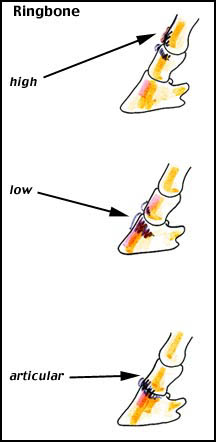|
The pastern area includes three bones and two joints. The bones are the long pastern bone, located just below the
fetlock joint to just above the coronary band; the short pastern bone, from the end of the long pastern to the coffin bone; and the coffin bone within the hoof wall. The long and short pastern bones are jointed, as are the short pastern and coffin bone.
Ringbone is divided into categories based on location--that is, high or low ringbone--and type, articular or non-articular. These categories are important as they often determine the horse's long-term prognosis.

Articular ringbone is a fairly serious type of arthritis that may affect either of the two joints. High ringbone occurs at the joint of the long and short pastern articulation. Low ringbone occurs at the short pastern - coffin bone articulation.
Non-articular ringbone refers to new bone growth on any of the three bones. This type of ringbone is also divided into high (upper pastern) and low (short pastern and coffin bone).
Ringbone more commonly occurs on the front legs, and owners may initially observe a moderate-to-severe lameness with a firm swelling in the pastern area. Heat and pain on deep pressure may also be evident. As the disease progresses, a bony deformation in the pastern or coffin joint region may develop. As the lameness becomes more progressive, a firm, cool swelling will be evident over the pastern region.
In order to diagnose ringbone, your vet should perform a thorough lameness examination. Radiographs are essential in determining if ringbone is present and of what type.
If diagnosed early in the course of the disease, before significant bony or articular changes occur, horses may be helped by rest, anti-inflammatory drug intervention, intra-joint medications, such as steroids, PSGAG and meticulous hoof care--trimming, shoeing and balancing. Farriers often find that a bar shoe helps.
More advanced stages of non-articular ringbone may even respond to these therapies. Articular ringbone (high or low) usually progresses to persistent, severe lameness.
The pastern joint is a low-motion joint and if diagnosed early enough, surgical options are now available to improve the horse's condition. Most of these procedures involve immobilization of the pastern joint using orthopedic implants.
|
Prognosis guarded
Long-term soundness in horses diagnosed with ringbone varies a great deal.
|
| TYPE |
PROGNOSIS |
| Articular low ringbone |
very poor |
| Articular high ringbone |
|
| -conservative therapy |
poor |
| -surgical intervention |
fair to good |
| Non-articular high ringbone |
good |
| Non-articular low ringbone |
poor |

|